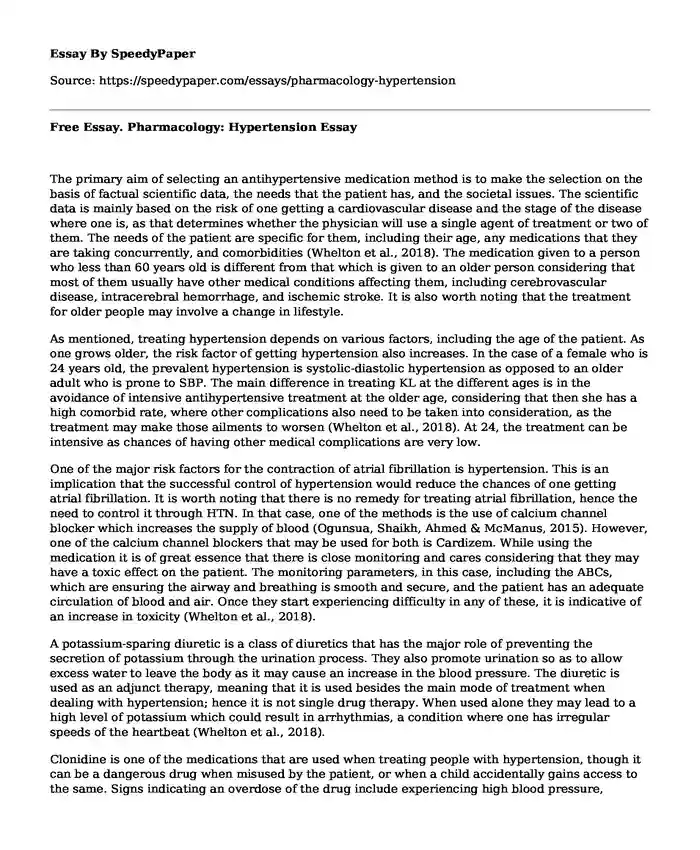
| Type of paper: | Essay |
| Categories: | Data analysis Pharmacology Drug Community health |
| Pages: | 3 |
| Wordcount: | 768 words |
The primary aim of selecting an antihypertensive medication method is to make the selection on the basis of factual scientific data, the needs that the patient has, and the societal issues. The scientific data is mainly based on the risk of one getting a cardiovascular disease and the stage of the disease where one is, as that determines whether the physician will use a single agent of treatment or two of them. The needs of the patient are specific for them, including their age, any medications that they are taking concurrently, and comorbidities (Whelton et al., 2018). The medication given to a person who less than 60 years old is different from that which is given to an older person considering that most of them usually have other medical conditions affecting them, including cerebrovascular disease, intracerebral hemorrhage, and ischemic stroke. It is also worth noting that the treatment for older people may involve a change in lifestyle.
As mentioned, treating hypertension depends on various factors, including the age of the patient. As one grows older, the risk factor of getting hypertension also increases. In the case of a female who is 24 years old, the prevalent hypertension is systolic-diastolic hypertension as opposed to an older adult who is prone to SBP. The main difference in treating KL at the different ages is in the avoidance of intensive antihypertensive treatment at the older age, considering that then she has a high comorbid rate, where other complications also need to be taken into consideration, as the treatment may make those ailments to worsen (Whelton et al., 2018). At 24, the treatment can be intensive as chances of having other medical complications are very low.
One of the major risk factors for the contraction of atrial fibrillation is hypertension. This is an implication that the successful control of hypertension would reduce the chances of one getting atrial fibrillation. It is worth noting that there is no remedy for treating atrial fibrillation, hence the need to control it through HTN. In that case, one of the methods is the use of calcium channel blocker which increases the supply of blood (Ogunsua, Shaikh, Ahmed & McManus, 2015). However, one of the calcium channel blockers that may be used for both is Cardizem. While using the medication it is of great essence that there is close monitoring and cares considering that they may have a toxic effect on the patient. The monitoring parameters, in this case, including the ABCs, which are ensuring the airway and breathing is smooth and secure, and the patient has an adequate circulation of blood and air. Once they start experiencing difficulty in any of these, it is indicative of an increase in toxicity (Whelton et al., 2018).
A potassium-sparing diuretic is a class of diuretics that has the major role of preventing the secretion of potassium through the urination process. They also promote urination so as to allow excess water to leave the body as it may cause an increase in the blood pressure. The diuretic is used as an adjunct therapy, meaning that it is used besides the main mode of treatment when dealing with hypertension; hence it is not single drug therapy. When used alone they may lead to a high level of potassium which could result in arrhythmias, a condition where one has irregular speeds of the heartbeat (Whelton et al., 2018).
Clonidine is one of the medications that are used when treating people with hypertension, though it can be a dangerous drug when misused by the patient, or when a child accidentally gains access to the same. Signs indicating an overdose of the drug include experiencing high blood pressure, sweating profusely and fainting, drowsiness, weakness, sinus bradycardia which is prevalent on children when they get the medication, the skin turning pale and cold, and at times difficulty in breathing. When used as an inhibitor of hypertension, clonidine has an effect on the cardiovascular that is biphasic. This implies that when used it creates a situation where there is a rise in the blood pressure before it drops again after some time (Whelton et al., 2018).
References
Ogunsua, A., Shaikh, A., Ahmed, M., & McManus, D. (2015). Atrial Fibrillation and Hypertension: Mechanistic, Epidemiologic, and Treatment Parallels. Methodist Debakey Cardiovascular Journal, 11(4), 228-234. doi: 10.14797/mdcj-11-4-228
Whelton, P., Carey, R., Aronow, W., Casey, D., Collins, K., & Dennison Himmelfarb, C. et al. (2018). 2017 ACC/AHA/AAPA/ABC/ACPM/AGS/APhA/ASH/ASPC/NMA/PCNA Guideline for the Prevention, Detection, Evaluation, and Management of High Blood Pressure in Adults: A Report of the American College of Cardiology/American Heart Association Task Force on Clinical Practice Guidelines. Hypertension, 71(6). doi: 10.1161/hyp.0000000000000065
Cite this page
Free Essay. Pharmacology: Hypertension. (2023, Jan 17). Retrieved from https://speedypaper.net/essays/pharmacology-hypertension
Request Removal
If you are the original author of this essay and no longer wish to have it published on the SpeedyPaper website, please click below to request its removal:
- Problem Solving Essay Example on film Ex Machina
- Essay Sample on Communication Styles Between Men and Women
- Essay Examples on Hyponatremia in Children
- Japanese Culture Essay Sample
- Free Essay with the Study Review: The Link Between Hemodialysis and Sleep Disorders
- Essay Sample on Population Health Project
- Paper on Community Health Needs Assessment & Strategic Implementation Plan - Chicago
Popular categories




